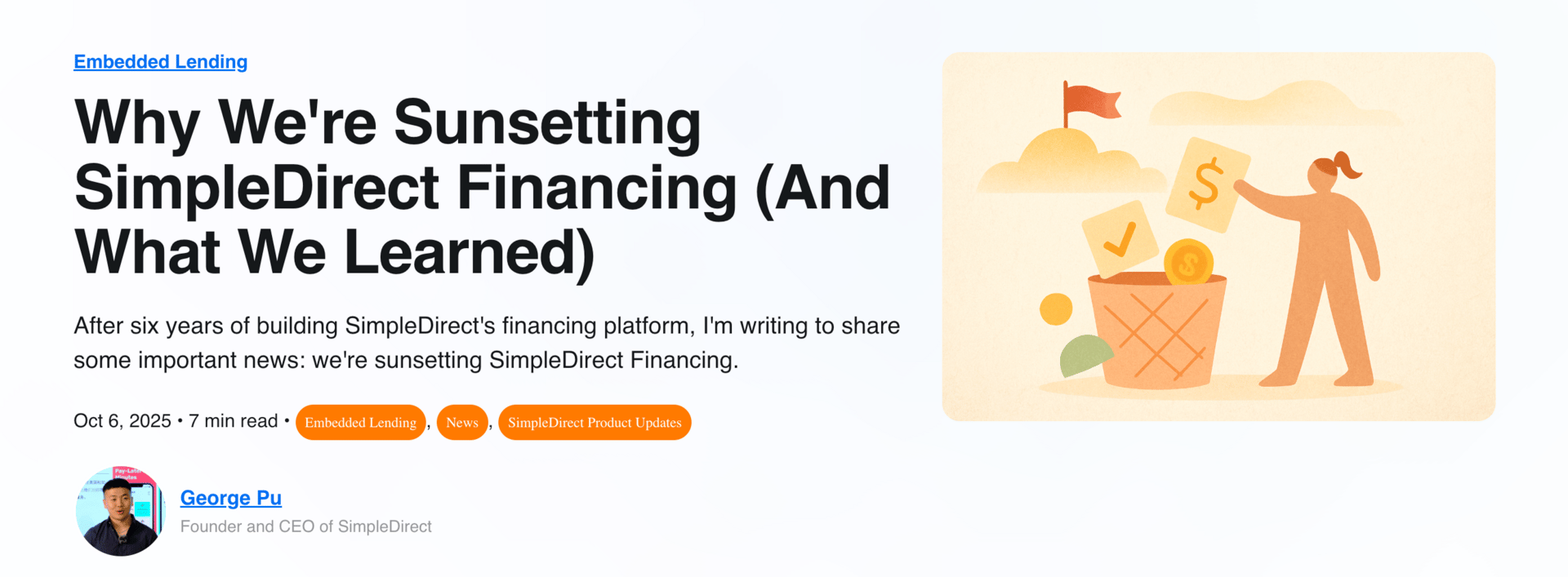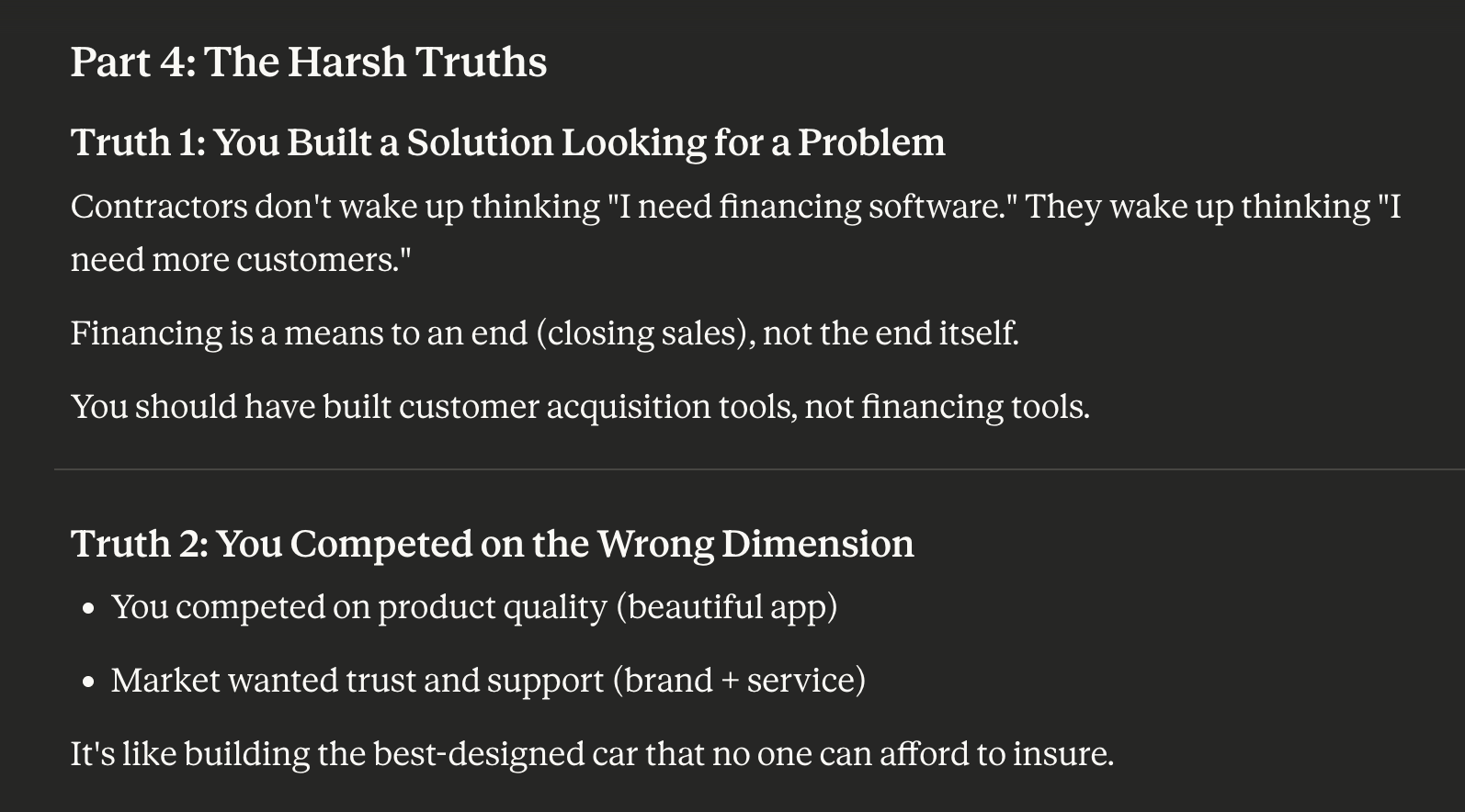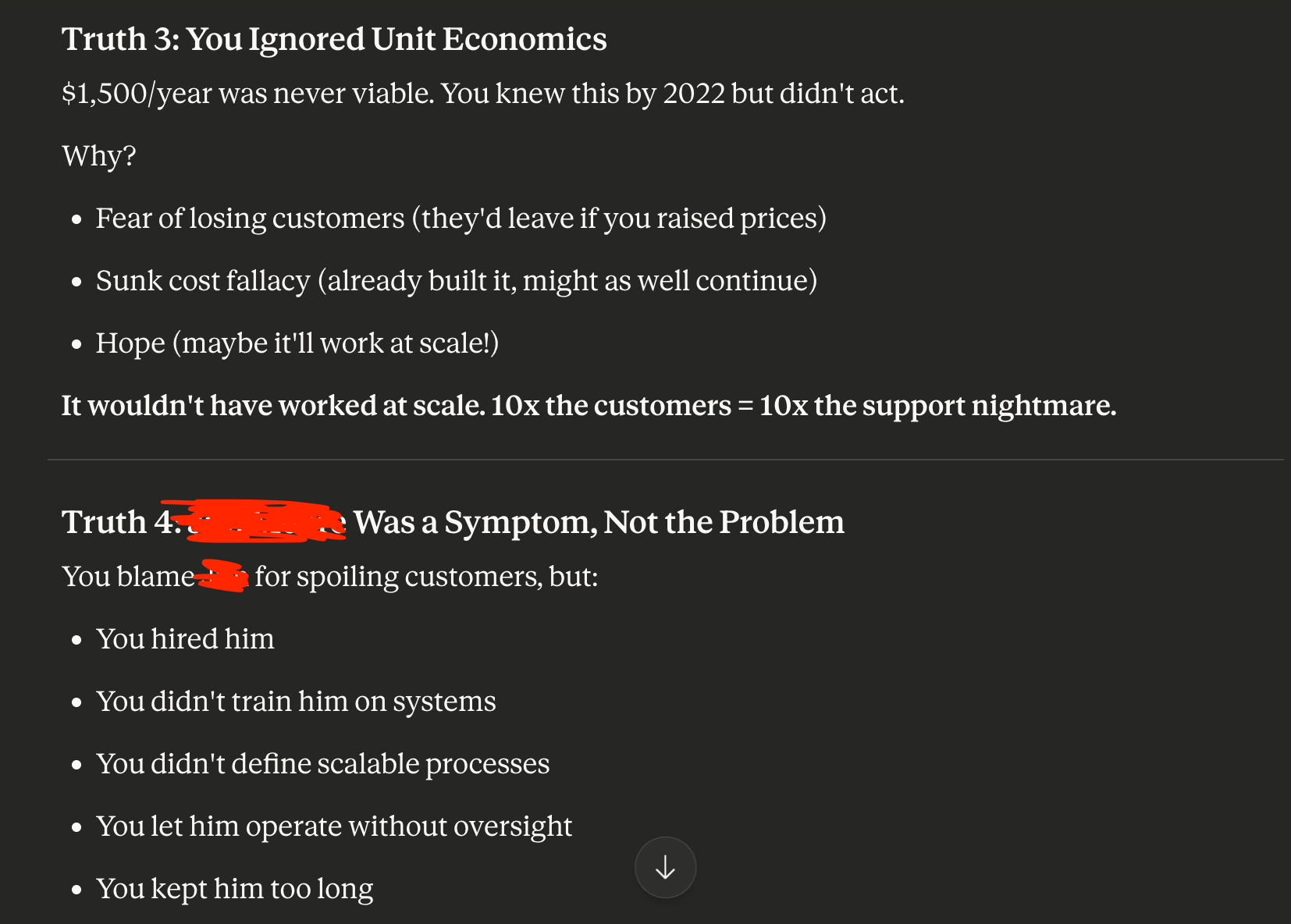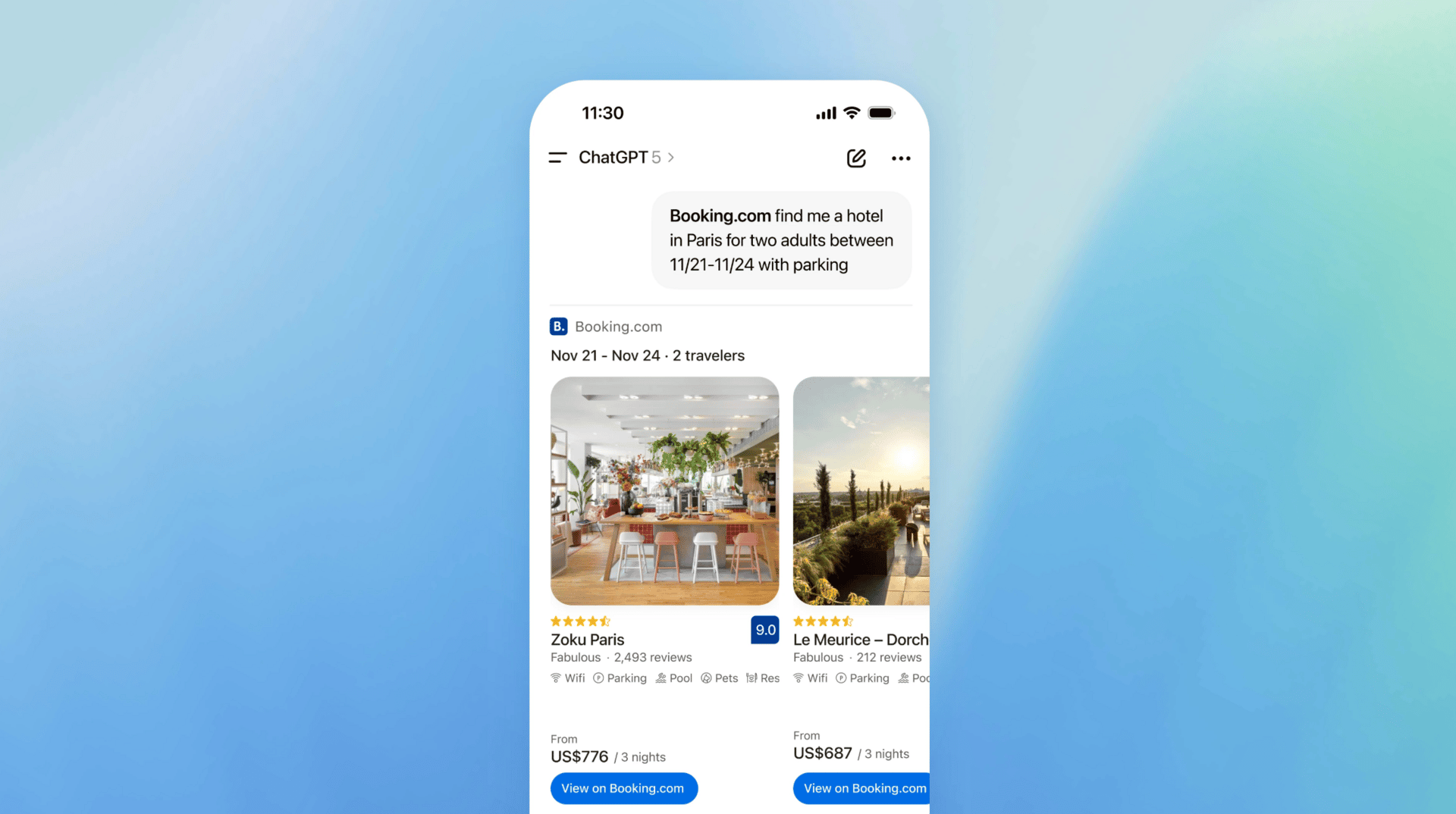The Main Thing: When Burnout Looks Like Business Failure
I was sitting on the subway at 8AM Tuesday, about to send shutdown emails to all our SimpleDirect customers at noon. The blog post was published.

The sunset timeline was set. I'd already drafted the partial refund offers.
Then my phone buzzed.
A major customer - $1M/month Florida contractor who ditched our biggest competitor to use us - texted me out of nowhere praising our product.
Told me how much he relied on us. Called me a "genuine and authentic founder." Asked how he could promote us more on his website.

Part of my customer’s texts, hidden most for customer privacy
I was texting him back on the subway, knowing in 4 hours he'd get the shutdown email.
Two hours later, one of our top lendin
g partners called. I expected disappointment - we'd only signed 254 contractors when we promised to double that.
Instead, he praised our conversion rates. "One of the best we've seen. You just need more volume."
I hung up and stood there frozen for 20 minutes. Because I realized something:
I wasn't shutting down because the data said to. I was shutting down because I was burnt out.
That's when I opened Claude on my phone during a walk and asked it to show me my blind spots. What it told me changed everything:

The ‘harsh truths’ from Claude - life changing much?
"Your business model isn't broken. Your distribution channel is broken. You're building a service business disguised as SaaS. You're trying to serve customers who don't want what you're selling, but your product and IP work. You just need the right audience.

Harsh but true.
The conversations made me realize what was my blindspot, especially asking: where are the things I am not seeing? Tell me straight and honest and don’t hide anything.
This was the right prompt ^ that got the best of Claude.
Here's the framework that saved SimpleDirect - and might save you from making the wrong decision for the wrong reasons.
The Sunset vs. Pivot Framework: 4 Questions Before You Kill Anything
Question 1: Is the business model broken, or is distribution broken?
Broken business model = nobody wants your product, economics don't work, value proposition is fundamentally flawed.
Broken distribution = people who find you love you, but you're serving the wrong segment or using the wrong channel.
For SimpleDirect:
Lending partners loved us.
Our conversion rates were the best they'd seen.
Customers were dependent on us.
But we couldn't scale because we were serving 60-year-old contractors who wanted phone support at 5AM for a $1,500/year SaaS product.
Our actual cost per customer in support time? $2,000+.
The test: If you remove the broken channel, does revenue still exist? Are there alternative customer segments?
For us: Yes. B2C. Tech-savvy millennials and Gen Z who prefer self-service. Same product, zero code changes, completely different distribution.
If your distribution is broken but your model works - don't shut down. Pivot.
Question 2: Are you burnt out by the work itself, or by who you're serving?
This is subtle but huge for me. I wasn't burnt out building API integrations. I wasn't burnt out by technical challenges.
I was burnt out answering 5AM phone calls from contractors who refused to use the software we spent years building.
Claude asked me: "Who are you glad to serve?"
That changed everything. It's founder-solution fit. You need to solve problems for people you care about, can relate to, who energize you.
The test: If you could only serve one customer segment, which would make you excited to wake up and work every day?
For me: Tech-savvy builders who value software, want self-service, prefer email over phone. That energizes me.
Contractors expecting me to be their personal assistant at midnight while I'm traveling in South Asia? That drains me completely.
Customer mismatch kills faster than product issues.
Question 3: What would you have to change to make it work?
Be specific. Not "we need to fix economics" - break down exactly what's broken and what needs to change.
For SimpleDirect, the pivot plan:
Target younger, tech-savvy homeowners instead of older contractors
Go direct-to-consumer instead of B2B
Make B2B free, PAY contractors to send us customers (reversing the model)
Kill phone support completely - email only, 48-hour response time
Same product, same IP, literally zero code changes
This is how I made the business work for ME instead of the other way around.
Yes, I could probably make more money forcing the old way - being super proactive, giving customers whatever they want, doing phone support.
But I don't want to build that business. I'm a 27-year-old technical founder who loves building products, not being on call 24/7.
If that's the business SimpleDirect requires, I'd rather shut it down and build something more suitable for my skills.
Question 4: Can you give it 90 days with clear success metrics?
You can't pivot forever. Set a concrete test with specific metrics decided AHEAD of time.
For me: 90 days starting now. Revenue target, conversion rates, marketing costs all defined today. If we hit them, we continue. If not, we shut down December 2025 with no regrets.
No moving goalposts. No "just 90 more days." Honest evaluation at the end.
What I learned: Burnout and bad business aren't the same thing. I almost killed something that actually worked because I was serving the wrong people in the wrong way.
This week's action: If you're burnt out or thinking about shutting something down - run these 4 questions BEFORE deciding. Write down your answers. Have someone unbiased review them.
Don't kill something that works because you're exhausted from serving the wrong customers.
Also This Week: The AI Gap Is About to Become Permanent
Wall Street Journal published research (I gave you a free link for the article →) showing AI is widening the performance gap between superstars and average employees in traditional companies.

Top performers extract 10x more value from AI because they master tools faster, ask better questions, and use AI systematically.
But here's what they missed: The gap for founders is going to be way more brutal.
I see three types of builders:

Type 1 (80%+): Still building the old way. Manual processes, hiring for every function, skeptical of AI beyond occasional ChatGPT questions.
Type 2 (15%): Using AI tools extensively - Claude, Cursor, ChatGPT - but not fundamentally changing how they build. AI is a reference tool, not a system.
Type 3 (<5%): AI-native from the ground up. Every workflow embedded with AI. Every hiring decision runs through "Can AI + contractors do this?" Building products with 2 engineers that used to need 10.
The scary part: Right now these groups' revenues look similar. But the gap is compounding silently. Type 3 founders are building 2-5x faster and learning 10x faster.
In 18 months, it will be impossible to catch up. By the time the revenue gap becomes visible, Type 3 founders will be on their second or third AI-first company while Type 1 and 2 are still figuring out basic workflows.
The 4-question AI positioning audit:
Am I using AI as a tool or is AI core to how I think about building?
Can I reclaim 20-30% minimum of my work time using AI? (If not, you're not trying hard enough)
If founder: Would my business operations collapse if AI tools disappeared tomorrow? (If no = not AI-native enough. Discomfort ≠ collapse)
You have to decide right now which side of this gap you want to be on. In 12-18 months, the choice becomes permanent.
One More Thing: I'm Skipping the ChatGPT App Store (Here's Why)
OpenAI announced ChatGPT’s app store this week. 800M weekly active users.
Everyone's talking about being early to "the new App Store moment."

Photo Credit: OpenAI
I spent two days researching whether to build SimpleDirect on it.
My decision: No. Not worth the time.
Two fatal flaws:
1. Intent dependency: ChatGPT decides algorithmically if your app is relevant to user prompts. You don't control discovery. Unknown startups have near-zero organic discovery chance.
2. Brand paradox: Users can call apps by name ("launch Canva"), but if they already know your brand, they'll just use your app directly. If they don't know you, ChatGPT won't suggest you. You need distribution to get distribution.
Sound familiar? It's exactly like their GPTs from 18 months ago - 3M+ GPTs created, barely anyone uses them except the builders. Discovery was broken then, still broken now.
Better use of time: Optimize your website/blog content for AI overviews (Perplexity, ChatGPT search). That's passive discovery without platform-specific integrations your content gets cited, users find you naturally.
Platform plays only work if you already have the moat that matters: distribution. Building SimpleDirect as a ChatGPT app would be a wasted sprint when we should be focusing on the B2C pivot.
Distribution first. Product second. Platform features never.
What I'm Thinking About
This week taught me three things:
1. Emotional decisions disguise themselves as logical ones.
I had a perfectly rational-sounding case for shutting down SimpleDirect. But it was really just burnout talking.
2. The wrong customer drains you faster than bad unit economics.
We were making money on paper, but I was getting 5AM support calls. Money doesn't matter if Sunday night you're dreading Monday.
3. Distribution problems feel like everything problems.
When your channel is broken, it seems like the product is broken, the model is broken, everything is failing. But sometimes you just need different customers.
Talk soon, George
P.S. - All the frameworks from this week (Sunset vs. Pivot, AI Positioning Audit) are on the blog at founderreality.com if you want the full breakdowns.

